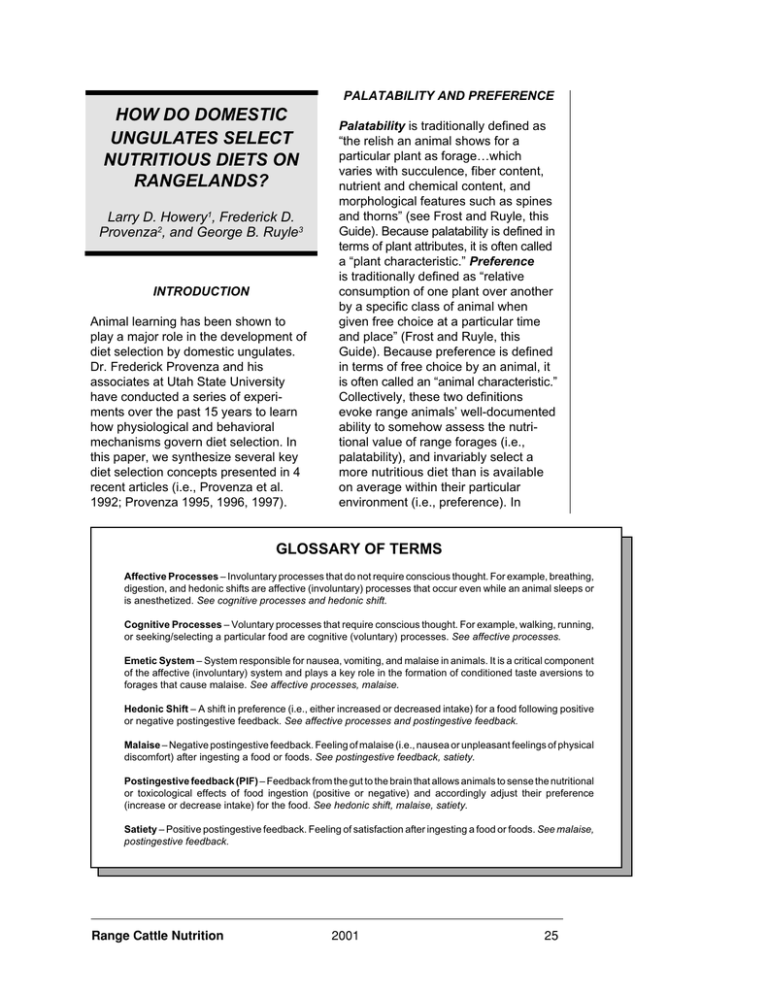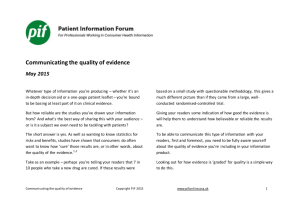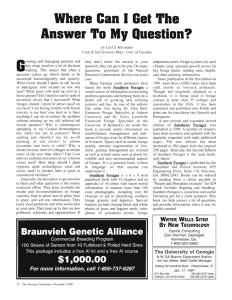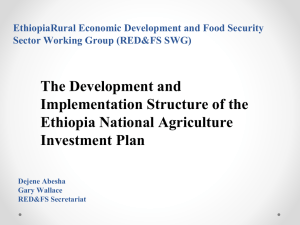HOW DO DOMESTIC UNGULATES SELECT NUTRITIOUS DIETS ON
advertisement

PALATABILITY AND PREFERENCE HOW DO DOMESTIC UNGULATES SELECT NUTRITIOUS DIETS ON RANGELANDS? Larry D. Howery1, Frederick D. Provenza2, and George B. Ruyle3 INTRODUCTION Animal learning has been shown to play a major role in the development of diet selection by domestic ungulates. Dr. Frederick Provenza and his associates at Utah State University have conducted a series of experiments over the past 15 years to learn how physiological and behavioral mechanisms govern diet selection. In this paper, we synthesize several key diet selection concepts presented in 4 recent articles (i.e., Provenza et al. 1992; Provenza 1995, 1996, 1997). Palatability is traditionally defined as “the relish an animal shows for a particular plant as forage…which varies with succulence, fiber content, nutrient and chemical content, and morphological features such as spines and thorns” (see Frost and Ruyle, this Guide). Because palatability is defined in terms of plant attributes, it is often called a “plant characteristic.” Preference is traditionally defined as “relative consumption of one plant over another by a specific class of animal when given free choice at a particular time and place” (Frost and Ruyle, this Guide). Because preference is defined in terms of free choice by an animal, it is often called an “animal characteristic.” Collectively, these two definitions evoke range animals’ well-documented ability to somehow assess the nutritional value of range forages (i.e., palatability), and invariably select a more nutritious diet than is available on average within their particular environment (i.e., preference). In GLOSSARY OF TERMS Affective Processes – Involuntary processes that do not require conscious thought. For example, breathing, digestion, and hedonic shifts are affective (involuntary) processes that occur even while an animal sleeps or is anesthetized. See cognitive processes and hedonic shift. Cognitive Processes – Voluntary processes that require conscious thought. For example, walking, running, or seeking/selecting a particular food are cognitive (voluntary) processes. See affective processes. Emetic System – System responsible for nausea, vomiting, and malaise in animals. It is a critical component of the affective (involuntary) system and plays a key role in the formation of conditioned taste aversions to forages that cause malaise. See affective processes, malaise. Hedonic Shift – A shift in preference (i.e., either increased or decreased intake) for a food following positive or negative postingestive feedback. See affective processes and postingestive feedback. Malaise – Negative postingestive feedback. Feeling of malaise (i.e., nausea or unpleasant feelings of physical discomfort) after ingesting a food or foods. See postingestive feedback, satiety. Postingestive feedback (PIF) – Feedback from the gut to the brain that allows animals to sense the nutritional or toxicological effects of food ingestion (positive or negative) and accordingly adjust their preference (increase or decrease intake) for the food. See hedonic shift, malaise, satiety. Satiety – Positive postingestive feedback. Feeling of satisfaction after ingesting a food or foods. See malaise, postingestive feedback. Range Cattle Nutrition 2001 25 addition to selecting nutritious diets, range animals generally avoid plants that cause toxicosis, inhibit digestion, or cause malnutrition. This is remarkable given that nutrients, toxins, and digestion inhibitors vary seasonally and by location, both among and within plant species. Animals do occasionally overingest plant nutrients and toxins (discussed later), but generally speaking, range herbivores commonly select forages that meet their nutritional needs and avoid forages that do not. Although this observation has been often reported in the literature, Dr. Provenza’s research is the first to offer both theoretical and experimental evidence that explains how this important process occurs. His work suggests that animal preference for foods (and hence their palatability) are best understood as the interrelationship between a food’s taste and its postingestive effects, which is determined by a food’s chemical (and physical) characteristics, and by an animal’s age, morphology, and physiological condition. POSTINGESTIVE FEEDBACK (PIF) AND HEDONIC SHIFTS Animals regulate their intake of forages according to whether postingestive feedback (PIF) that results from forage ingestion is positive or negative. Animals change their “preference” for various forages (i.e., forages become more or less “palatable” and relatively more or less “preferred”) in accord with PIF. This process is know as a hedonic shift. For example: . . Lambs develop strong preferences even for poorly nutritious foods such as straw (i.e., increased intake, a positive hedonic shift) when it is eaten during stomach tubings of energy (starch or glucose) or nitrogen (urea, casein, gluten). Conversely, lambs quickly learn to avoid a previously palatable food (i.e., decreased intake, a negative hedonic shift) after receiving one dose of lithium chloride (LiCl), a compound that causes nausea. These results demonstrate that palatability and preference can be manipulated experimentally. However, palatability and preference are also altered in nature when chemical composition of rangeland plants (i.e., forage quality) changes across space (e.g., range sites differing in kind and amount of available forage) and time (e.g., decline in forage quality as plants mature). Figure 1. Schematic representation of affective and cognitive processes in diet selection. The affective system links the taste of food with its postingestive feedback (PIF). The cognitive system integrates the senses of taste, smell, and sight which animals use to seek or avoid foods in accord with positive or negative PIF. There is an iterative exchange of information between these systems which allows animals to modify their foraging behavior in response to changing environmental conditions, and in response to changing nutritional needs (adpated from Provenza et al., 1992).4 Range Cattle Nutrition AFFECTIVE AND COGNITIVE SYSTEMS Two interrelated systems mediate hedonic shifts via PIF from the gut to the brain: affective systems and cognitive systems. Affective involuntary processes are mediated subconsciously; cognitive processes are 2001 26 mediated consciously. The senses of taste, smell, and sight are linked with PIF across the two systems, but are functionally different (Figure 1). We will discuss affective and cognitive systems (and their affiliated senses) separately in order to highlight their primary functions, but this does not mean they operate independently of one another. Animals readily exchange information between these two systems through their senses of taste, smell, and sight. Affective (involuntary) processes allow animals to associate the taste of forages with their positive or negative PIF and respectively form either conditioned preferences or conditioned aversions. If a forage causes malaise (i.e., nausea), animals acquire conditioned taste aversions (mild to strong). Malaise may occur when the forage ingested contains excess nutrients (e.g., energy, protein, minerals), excess toxins (e.g., tannins, alkaloids), or inadequate nutrients (Figure 2). What constitutes excesses and deficits in nutrients or toxins depends on the animal’s age, morphology (e.g., small vs. large animal, ruminant vs. cecal digestive system), and physiological condition (Figure 3). On the other hand, if a forage causes satiety (the sensation of being satisfied to the full), animals acquire conditioned taste preferences (mild to strong). Satiety results when an animal ingests the kinds and amounts of forages necessary to meet its nutritional requirements, again depending on age, morphology, and physiology. Cognitive (voluntary) processes allow animals to integrate the senses of taste, smell, and sight to discriminate among forages and make “conscious” choices (i.e., behavioral modification) to select or avoid a food based on previous experience with the food’s PIF (Figure 1). If a food previously resulted in malaise (i.e., negative PIF), its taste becomes undesirable and the animal uses its senses of smell and sight to Range Cattle Nutrition Figure 2. Preference is dependent on how adequately a food satisfies an animal’s particular nutritional requirements. Preference resides along a continuum, wherein foods with low or excessive concentrations of nutrients (or excessive concentrations of toxins) cause preference to decline, and foods with adequate amounts of nutrients cause preference to increase (adapted from Provenza 1995).4 Figure 3. Animal nutrient requirements vary with age and physiological condition. The ideal nutritional state (center line) occurs when all nutrients are obtained simultaneously. It is dynamic and multidimensional, with as many dimensions as there are functionally relevant nutrients. However, animals need not maximize (optimize) intake of any particular nutrient or mix of nutrients within each meal or even on a daily basis, because they can withstand departures from the normal average intake of nutrients (i.e., energy-rich substances, nitrogen, various minerals, and vitamins). Rather, homeostatic regulation needs only some increasing tendency, as a result of a gradually worsening deficit of some nutrient (lower line) or of an excess of toxins or nutrients (upper line), to generate conditions (i.e., malaise) to correct the disorder (i.e., cause the animals to change food selection). Malaise causes animals to increase diet breadth, to acquire preferences for foods that rectify states of malaise, and to exhibit state-dependent food selection (adapted from Provenza 1995).4 2001 27 avoid the forage in the future; the converse would occur if a food previously resulted in satiation (i.e., positive PIF). To summarize, animals use the affective system to evaluate the postingestive consequences of ingesting a forage, and the cognitive system to modify their foraging behavior according to whether PIF was positive or negative. Although animals integrate the senses of taste, smell, and sight to seek or avoid foods that have respectively caused positive or negative PIF, taste is most strongly linked with PIF. Animals first relate the taste of a food with its PIF through the affective (involuntary) system before smell and sight become functional in the cognitive (voluntary) system (Figure 1). Hence, foraging behavior entails a neverending exchange of information systems whereby animals sample forages, associate positive or negative PIF from the digestive tract with a forage’s taste, integrate forage taste with smell and sight, and then seek or avoid forages accordingly. Together, these two systems give animals flexibility to learn and modify their foraging behavior in response to changing environmental conditions (e.g., variation in plant nutrients and toxins across space and time), and in response to changing nutritional needs (old vs. young, lactating vs. non-lactating, etc.). CONDITIONED TASTE AVERSIONS Conditioned taste aversions have evolved as a survival mechanism to help animals limit their intake of otherwise nutritious plants that contain toxins, or plants that fail to meet nutritional requirements. Supporting this notion is the fact that conditioned taste aversions have been demonstrated in many different animal species (e.g., snakes and tiger salamanders; quail, blackbirds, blue jays, and crows; rats, opossums, and mongooses; coyotes and timber wolves; goats, Range Cattle Nutrition sheep, and cattle; olive baboons and humans) using a variety of compounds. The emetic system is a critical component of the affective system (see previous section), and plays a key role in the formation of conditioned taste aversions to forages that cause malaise. The emetic system mediates interactions between the brain and the digestive tract and is the same system responsible for nausea and vomiting in humans. Because the emetic system is a subset of the affective system, it involves noncognitive or involuntary processes. Accordingly, aversive PIF may occur even as an animal sleeps, is anesthetized, or with short (i.e., less than 1 hour) or long delays (i.e., up to 12 hours) between food ingestion and PIF. This is critical because digestion and absorption rates (i.e., PIF) vary from fast to slow depending on animal species and forage characteristics. Although conditioned taste aversions (and preferences, discussed next section) are non-cognitive, this information is clearly integrated with the cognitive system through the senses of sight and smell. After animals relate a forage’s taste with negative PIF (malaise), smell and sight become powerful predictors of anticipated negative PIF and the cognitive response is to avoid the forage when encountered in the future (Figure 1). The emetic system may be stimulated (resulting in malaise and conditioned taste aversions) when animals ingest forages containing excess nutrients or toxins. There is also limited evidence that the emetic system may be stimulated when forages ingested contain inadequate nutrients (Figure 2). Some experimental and anecdotal examples of conditioned taste aversions follow. EXCESS NUTRIENTS . 2001 Ruminants prefer high-energy foods like grains, but limit grain intake and increase intake of alternative foods once grain is over28 . . . . ingested, evidently because negative PIF caused by excess by-products from microbial fermentation (i.e., volatile fatty acids such as lactate, acetate, and propionate) produces a negative hedonic shift within a meal. Sheep given a high dose of propionate during a meal (i.e., high energy) acquire a persistent aversion to the food. Ruminants eating foods high in rumen-degradable protein (through microbial fermentation) experience toxic levels of ruminal ammonia which cause declines in intake. Goats learn to limit intake of various sources of non-protein nitrogen within minutes of ingestion. For instance, urea is quickly converted into ammonia, which explains why intake rapidly declines as urea is added to foods. Sheep fed an oat hay-lupine mixture containing either 0, 1.7, 3.3, 6.3, 12, or 21% of a mineral mix ate less as the mineral concentration was increased. Most of the sheep consuming the highest mineral concentrations eventually refused to eat the food. EXCESS TOXINS . . Goats prefer old-growth to currentseason growth blackbrush (Coleogyne ramosissima) twigs, even though current-season growth contains more nitrogen (2.3 vs. 1.7%) and is more digestible (48 vs. 38%) than old-growth. This is because current-season growth contains a condensed tannin that causes aversive PIF. . . (Nolina microcarpa) (saponins, coumarins, furocoumarins, and anthraquinones) cause decreased intake in cattle, sheep, and goats. Various toxic compounds in leafy spurge (Euphorbia esula), bitterweed (Hymenoxys odorata), poor quality silage, and sagebrush (Artemisia spp.) contain compounds that decrease intake in range herbivores. Sheep quickly acquire aversions to foods containing the toxin lithium chloride (LiCl). INADEQUATE NUTRIENTS . . Deficits or imbalances of energy, nitrogen, and amino acids cause lambs and rats to decrease intake. Phosphorus deficient diets cause cattle, sheep, and goats to decrease intake; the decline in intake is directly related to the degree of the deficit. CONDITIONED TASTE PREFERENCES Conditioned taste preferences, like conditioned taste aversions, are mediated through the affective and cognitive systems, except of course, the cognitive response of animals is to seek forages that have previously caused positive PIF (Figure 1). Animals may form preferences and seek forages when their taste has been paired with adequate: 1) energy, 2) nitrogen, or 3) recovery from nutritional deficiencies or malaise. Some experimental and anecdotal examples of conditioned taste preferences follow. ENERGY AND PROTEIN Toxic compounds in larkspur (Delphinium barbeyi) and tall fescue (Festuca arundinacea) (alkaloids), brassica crops (glucosinolates), and sacahuista Range Cattle Nutrition . 2001 Lambs acquire strong preferences for non-nutritive foods (e.g., straw or grape pomace) or flavors (e.g., maple, apple, coconut, onion) 29 paired with energy sources (e.g., starch or glucose) or with volatile fatty acids (e.g., propionate or acetate) that are energy sources. . . Lambs also acquire strong preferences for flavored straw paired with protein (e.g., casein, gluten) or Nutrient Requirements in Perspective: animals require more energy than any other nutrient Calcium (7.7g) Phosphorus (3.9g) . Crude Protein (202 g) Lamb: 40 kg (88 lb) Gain: 345 g/d (3/4 lb/d) Total Digestible Nutrients (1160 g) Figure 4. Animals require more energy daily than any other nutrient. For example, a 40 kg lamb requires 1160 g of total digestible nutrients (TDN), but only 202 g of crude protein (CP), 7.7 g of calcium (Ca), and 3.9 g of phosphorus (P) to gain 345 g/d (3/4 lb/d) (NRC 1985). non-protein (e.g., urea) sources of nitrogen. Lambs acquire the strongest preferences when the sources of energy and nitrogen ferment at similar rates and in similar amounts in the rumen. Conversely, when the balance of energy and protein is skewed in rate or amount, animals tend to form aversions to the food. Energy and protein can both readily change preferences, but animals require much more energy than protein each day (Figure 4). Accordingly, animals typically acquire stronger preferences for non-nutritive foods paired with energy than with protein. However, meal to meal preference for energy and protein depends on whether energy and protein requirements were satisfied during previous meals. After a high-energy meal, lamb preference for energy declines and preference for protein increases; the converse is also true (Figure 5). RECOVERY FROM NUTRITIONAL DEFICIENCIES . . . Figure 5. Animals typically acquire stronger preferences for non-nutritive foods paired with energy than with protein. However, meal to meal preference for energy and protein depends on whether energy and protein requirements were satisfied during previous meals. After a high-energy meal, lamb preference for energy declines and preference for protein increases; the converse is also true. Range Cattle Nutrition . 2001 Lambs suffering from acidosis (excess energy) drink more of a sodium bicarbonate solution; lambs not suffering from acidosis prefer plain water. Cattle readily consume supplemental protein blocks when ingesting forages low in protein. When browsing a low-protein blackbrush diet (1.5% nitrogen), goats consume woodrat houses soaked in urine (nitrogen). Sheep increase intake of a proteindeficient diet following infusions of protein into the duodenum. 30 . . . . Rats prefer flavors associated with their recovery from threonine (an amino acid) deficiency. Sheep apparently rectify mineral deficits (e.g., P, S, and Se) by ingesting mineral supplements; cattle consume non-food items, apparently to rectify P deficiencies. Deer and other ungulates experiencing mineral deficits eat antlers. Bighorn sheep that use rodent middens as mineral licks may do so to rectify nutrient deficiencies. Cattle ingesting mineral deficient forages lick urine patches of rabbits and man, chew wood, consume soil, eat fecal pellets of rabbits, and ingest non-food items such as plastic, feathers, bones, cinders, sacks, and tins. Mineral deficient cattle also eat rabbit flesh and bones, whereas non-deficient animals may sniff or lick the flesh, but never eat it, and they ignore the bones. Other ruminants experiencing various nutrient deficiencies have been known to eat the following: live and dead lemmings, rabbits, birds (caribou, red deer, sheep), ptarmigan eggs (caribou), arctic terns (sheep), and fish (white-tailed deer). SAMPLING FAMILIAR VS. NOVEL FORAGES Animals may frequently change intake of familiar foods in familiar environments because the nutrient and toxin content of familiar plants can change dramatically within a matter of hours or even minutes depending on previous herbivory and/or environmental conditions. If toxicity decreases (or nutrient content increases), the food is no longer paired with negative PIF and intake may increase. Conversely, forage intake may decrease as forage Range Cattle Nutrition toxicity increases or as nutrient content decreases. Thus, forage sampling and PIF provide animals with a means of tracking and adapting to changes in nutrients and toxins in familiar foraging environments. Animals sample new (novel) forages even more cautiously than familiar forages evidently because the postingestive consequence of ingesting a new forage is unknown. Animals are apt to “blame” a novel food for negative PIF even when it is not responsible for the malaise. For instance, young animals that were given LiCl (i.e., negative PIF) avoided a novel food when fed a combination of one nutritious-novel and four nutritious-familiar foods even though one of the familiar foods actually contained the LiCl. “Blaming” novel rather than familiar forages for aversive postingestive consequences likely evolved as a means of protecting herbivores from over-ingesting potentially harmful new foods before confirming their PIF (i.e., positive or negative) by careful sampling as described above. Thus, range herbivores routinely sample both nutritious and toxic forages (both familiar and novel) and regulate forage intake according to whether PIF is positive or negative. In addition to sampling and PIF, different animal species have evolved specialized physiological mechanisms that bind, metabolize, or detoxify certain thresholds of harmful plant compounds. However, the capacity of these mechanisms is seldom exceeded because animals quickly acquire taste aversions and limit intake before toxicosis ensues. Physiological mechanisms work in concert with PIF, and provide animals flexibility to regulate their intake and ingest adequate diets in everchanging foraging environments. This is impressive considering the millions of bites that range herbivores take each day across rangelands that contain a diverse array of nutritious and harmful plant compounds. 2001 31 WHY DO ANIMALS SOMETIMES OVERINGEST NUTRIENTS AND/OR TOXINS? Animals occasionally over-ingest plant nutrients and toxins that may cause declines in intake, production, and even death. This probably occurs whenever an animal fails to properly relate the taste or smell of a particular forage with its PIF, and the animal’s physiological means for binding, metabolizing, or detoxifying toxic compounds is exceeded. Any of the following scenarios (or combinations thereof) involving both the affective and cognitive systems could be responsible for such a breakdown. EMETIC SYSTEM NOT STIMULATED instead cause aversions to physical locations or other external stimuli. INTERACTIONS BETWEEN AVERSIVE AND POSITIVE PIF Animals are more likely to be poisoned when PIF from a toxin is not experienced for more than 12 hours. Beyond 12 hours, animals may not be able to distinguish which foods cause positive or negative PIF. The longer the delay between food ingestion and aversive feedback, and the higher proportion of positive to negative PIF during that time, the more likely it is that livestock will continue to ingest the food. . The emetic system apparently must be stimulated (i.e., malaise must be experienced by animals) to produce a conditioned taste aversion. However, over-ingestion of certain nutrients and toxins may not stimulate the emetic system. . . Animals that over-ingest alfalfa experience bloat and decrease short-term intake, apparently because tension receptors in the rumen and reticulum are stimulated which may cause short-term physical discomfort. However, bloat apparently does not stimulate the emetic system or cause a long-term negative hedonic shift because animals will ingest alfalfa soon after bloat subsides. In contrast, forages that stimulate the emetic system (cause malaise) have been avoided for at least 3 years. . Some toxic compounds (e.g., tannins) stimulate the emetic system and cause conditioned taste aversions. Other compounds (e.g., gallamine, naloxone) may not stimulate the emetic system but Range Cattle Nutrition 2001 Some animals may die from overingesting larkspur (D. barbeyi) because there is immediate positive PIF but delayed aversive PIF. For instance, cattle ingest larkspur because it initially enhances ruminal fermentation and digestion (i.e., it is high in energy and protein). Consumption generally increases over a 2 to 4 day period before declining dramatically when alkaloids have their maximum aversive effects. A somewhat similar scenario may occur when animals over-ingest alfalfa and become bloated. Positive PIF from nutrients may cause a strong liking for a nutritious food like alfalfa (i.e., a positive hedonic shift) that overrides any short-term physical discomfort (i.e., stimulation of tension receptors in the rumen and reticulum) due to bloat. Poisoning is delayed when animals consume various locoweed species (Astragalus and Oxytropis spp.) that contain indolizidine alkaloids. Cellular damage does not occur for 8 days and there are no clinical signs of poisoning for 3 weeks. Animals acquire aversions to such foods only after vital organs (e.g., the liver) have been damaged. 32 . Liver damage caused by pyrrolozidine alkaloids in species such as groundsel (Senecio spp.) is progressive and death may not occur for months or even years. familiar environment. These results suggest that animals generally perform better when foraging on familiar foods in familiar environments. DIFFERENTIATING NUTRITIOUS FROM TOXIC PLANTS IN UNFAMILIAR ENVIRONMENTS CHANGES IN ENVIRONMENTAL CONTEXT MAY ALTER ANIMAL PHYSIOLOGY It is probably more difficult for herbivores to differentiate nutritious from toxic foods in unfamiliar environments because all foods may be novel. Even when familiar plants are available in unfamiliar environments, changes in an animal’s environmental context may render its physiological mechanisms (e.g., binding, metabolizing, and detoxifying) less effective and cause animals to be more susceptible to toxicosis. In this case, the same dose of a familiar toxin may be more harmful in an unfamiliar than in a familiar environment. Work in this area has mainly involved drug research on humans and rats, but there are important implications concerning how range animals may respond to familiar toxic plants after being moved to an unfamiliar environment. . . . . . Ninety percent of naïve goats introduced into pastures containing white snakeroot (Eupatorium rugosum) died during the first 2 weeks of grazing. Survivors apparently learned to avoid the plant. Sheep in South Africa eat groundsel for the first 3 days in an unfamiliar pasture but then refuse to eat the plant even if starving. Cattle ranchers in South Africa stomach-tube a sublethal preparation of tulips (Homeria pallida) to prevent deaths, and report that only naïve or extremely hungry animals eat the plant. Naïve animals given the preparation, or untreated animals that survive beyond 4 days of grazing pastures containing the plant learn to avoid tulips. Many cattle deaths caused by larkspur (D. barbeyi) occur within 10 to 14 days after cattle enter a new pasture. Survivors may learn to avoid ingesting a lethal dose. . . . Social drinkers become more impaired when they drink at unusual times or in different settings. Rats with or without previous experience with heroin were given a strong dose either in a familiar or a unfamiliar environment. The dose was lethal for: . . . When foraging in a familiar environment, sheep ate less of a familiaraversive food than in an unfamiliar environment. Conversely, when foraging in an unfamiliar environment, sheep ate less of a novelharmless food than when in a Range Cattle Nutrition A cancer patient died when injected with morphine in a different room; the patient had tolerated the same dose when injected every 6 hours for 4 weeks in a familiar room. 2001 32% of the experienced rats in a familiar environment. 64% of the experienced rats in an unfamiliar environment. 96% of the inexperienced rats in an unfamiliar environment. 33 . Cows raised in Gila county Arizona and moved 100 miles east to Apache county suffered severe lupine and locoweed poisoning. Sister cows that remained in Gila county did not experience lupine or locoweed poisoning even though these species were available in small to moderate stands. SOCIAL FACILITATION Animals can also influence what one another eat. . A group of heifers that were averted to larkspur (with LiCl) avoided the plant over a 3-year period until they were placed in a pasture with nonaverted heifers, at which point they began eating larkspur at similar levels to the nonaverted heifers. SUBTLE MOLECULAR CHANGES INCREASE PLANT TOXICITY Animals may be unable to readily detect subtle molecular changes that increase plant toxicity. . . . hares, even though both shrubs contain condensed tannins. Slight chemical differences render condensed tannins in blackbrush more aversive to herbivores. TOXINS IN MORE THAN ONE PLANT It may be difficult for herbivores to associate toxicity with a specific food when the same toxin exists in more than one food, or when two or more compounds in different foods interact to cause toxicity. . . . Lambs were unable to detect that LiCl had been added to a previously “safe” familiar food (barley) when it was fed in combination with a novel food (milo). The lambs instead avoided milo and continued to eat the familiar barley, even though barley actually contained the toxin. Cattle typically increase intake of larkspur (D. barbeyi) after a drop in barometric pressure and mortality increases, probably because changes in plant chemistry simultaneously increase both the palatability and toxicity of the plant. Such changes likely increase susceptibility to poisoning. Bitterbrush (Purshia tridentata) is more palatable than blackbrush both for goats and snowshoe Range Cattle Nutrition . Goats and deer ingest many different browse species that are high in tannins. It may be difficult for them to distinguish PIF among several different plant species that contain the same (or nearly the same) compound. Sheep that consume hemlock (Cicuta spp.) may then be more susceptible to compounds in crown beard (Verbesina enceliodes). Sheep that consume black sagebrush (Artemesia nova) before horsebrush (Tetradymia glabrata) are predisposed to photosensitization. Photosensitization by itself is not likely to cause a food aversion because the emetic system is not directly stimulated, but liver dysfunction associated with ingesting these two plant species might indirectly stimulate the emetic system and ultimately cause a conditioned food aversion. Various locoweed species contain toxic nitrogen compounds and selenium, which when combined increases their toxicity. SUMMARY Animals continually sample and evaluate the nutritional value (i.e., PIF) of forages using their senses of taste, smell, and sight. Postingestive feed2001 34 back adjusts a forage’s hedonic value (i.e., preference and palatability) commensurate with its utility to the animal (i.e., animal age, morphology, and physiology) enabling survival when both the animal’s foraging environment and nutritional needs are constantly changing. Plant species that cause positive hedonic shifts are usually highly correlated with nutritional wellbeing, while plant species that cause negative hedonic shifts are typically highly correlated with nutrient deficiencies and toxicosis. Hence, what makes a forage taste “good or bad” (and thus, sought or avoided) is not taste per se, but rather nutritional benefits or deficits received from forage ingestion, which are sensed by animals through PIF and linked with a forage’s taste. Animals integrate and use their senses of taste, smell, and sight to seek foods that cause positive PIF (i.e., nutritional wellbeing) and avoid foods that cause negative PIF (i.e., nutrient deficiencies and toxicosis), and can thus be described as possessing a high degree of “nutritional wisdom.” This process occasionally breaks down when animals fail to properly link the PIF of a particular food with its taste, smell, or sight, and their physiological means for binding, metabolizing, or detoxifying toxic compounds is exceeded. ACKNOWLEDGMENTS We thank Roger Banner, Mick Holder, Robert Kattnig, and Jim Sprinkle for reviewing earlier drafts of this paper. Their comments and suggestions greatly improved the manuscript. LITERATURE CITED Provenza, F.D. “Feeding Behavior of Herbivores in Response to Plant Toxins.” Handbook of Plant and Fungal Toxicants. J.P. Felix D’ Mello, ed. CRC Press, Inc. 1997. Provenza, F.D. “Acquired Aversions as the Basis for Varied Diets of Ruminants Foraging on Rangelands.” J. Anim. Sci. 74(1996):2010–2020. Provenza, F.D. “Postingestive Feedback as an Elemental Determinant of Food Preference and Intake in Ruminants.” J. Range Manage. 48(1995):2–17. Provenza, F.D., J.A. Pfister, and C.D. Cheney. “Mechanisms of Learning in Diet Selection with Reference to Phytotoxicosis in Herbivores.” J. Range Manage. 45(1992):36–45. 1 Associate Professor and Rangeland Specialist, The University of Arizona 2 Professor, Range Science Department, Utah State University, Logan, UT 3 Professor and Rangeland Specialist The University of Arizona 4 Figures 1-3 were originally published in similar form in the Journal of Range Management. They are reproduced here by permission of the Journal. Range Cattle Nutrition 2001 35 FROM: Arizona Ranchers’ Management Guide Russell Tronstad, George Ruyle, and Jim Sprinkle, Editors. Arizona Cooperative Extension Disclaimer Neither the issuing individual, originating unit, Arizona Cooperative Extension, nor the Arizona Board of Regents warrant or guarantee the use or results of this publication issued by Arizona Cooperative Extension and its cooperating Departments and Offices. Any products, services, or organizations that are mentioned, shown, or indirectly implied in this publication do not imply endorsement by The University of Arizona. Issued in furtherance of Cooperative Extension work, acts of May 8 and June 30, 1914, in cooperation with the U.S. Department of Agriculture, James Christenson, Director, Cooperative Extension, College of Agriculture and Life Sciences, The University of Arizona. The University of Arizona College of Agriculture and Life Sciences is an Equal Opportunity employer authorized to provide research, educational information, and other services only to individuals and institutions that function without regard to sex, race, religion, color, national origin, age, Vietnam Era Veteran’s status, or handicapping conditions. Range Cattle Nutrition 2001 36






